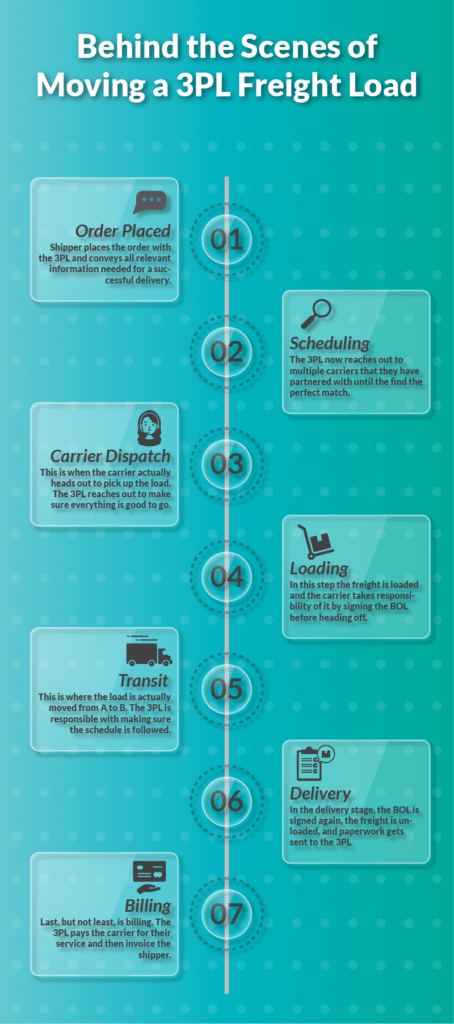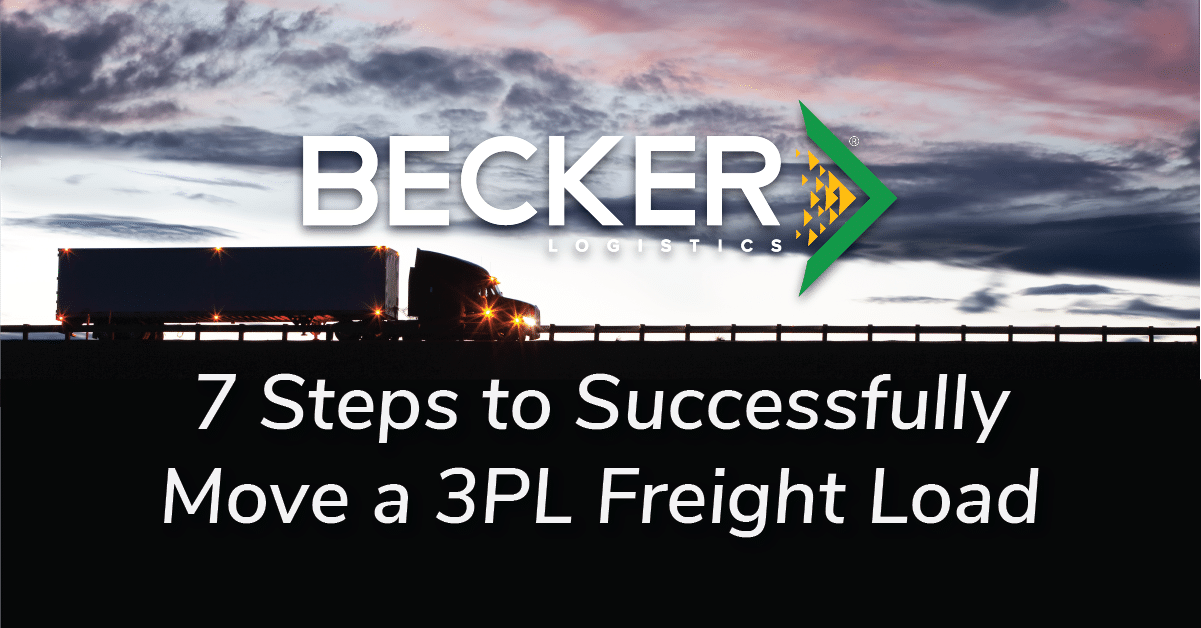Booking a 3PL freight load SHOULD be an easy and simple process for the shipper. However, there is a lot of action going on behind the scenes with the 3PL. There are account managers, load planners, carrier representatives, and accountants all in motion to ensure that the freight is shipped with little to no complication.
When partnered with a quality 3PL this entire process is only visible if the shipper wants to see it. The 3PL should be able to navigate through their process with minimum input while supplying regular updates. Doing so is one of the key components of quality in 3PL shipping.
This does result in a loss of control of the freight for the shipper. However, that comes along when booking a 3PL freight load, it’s inevitable. The freight is being handed off to someone else, someone that knows exactly what they are doing and has a process to ensure success. The trick is, for the shipper to find a 3PL that they can trust to give this control to. A company that has this process down to a science.
So, let’s take a look at the process of moving the load. There are seven steps to move a 3PL freight load successfully and completely.
Behind the Scenes of Moving a 3PL Freight Load:
Order Placed
The first thing needed to move a load is to… place an order. Ideally, there is some kind of relationship in place and the shipper isn’t scrambling after a carrier dropped them and they’re stuck with their freight.
In this step, the shipper needs to provide all the necessary information to ship the load. Contact information, pick-up and drop-off details, information on the freight, and so on. The information can be sent via phone, email, or EDI.
After this step, the load should be able to be moved without any more input from the shipper.
Scheduling
Alright, the 3PL has the dates, times, and freight details. Next up, is finding a carrier that they know can handle this freight and deliver it right.
This is the step that separates an okay 3PL from a great one. The 3PL’s carrier base and its relations with those carriers are vital. There would be no shipping without it.
The 3PL is scrounging their database of proven and ranked carriers to find one that fits the price, has the right equipment, insurance, and availability. There is a lot of negotiation in this step because the 3PL is out to find the best match that will work for the carrier, shipper, and themselves.

Carrier Dispatch
This step occurs when it’s time to actually pick up the load. It may have been several days since the scheduling so it is useful to go over the details again. Make sure that the trailer, the pick-up time, and location are correct, and any pick-up instructions are relayed on.
Overall, this is to ensure that everything is still on schedule and that the freight will be picked up on time.
Loading
Loading the freight is simple enough (most of the time). In this stage, the 3PL is staying in contact with the carrier to ensure that everything is going smoothly. One very important aspect of this step is ensuring that the carrier signs the Bill of Lading (BOL) which signifies that they have taken the freight and are now responsible for it.
After everything is signed and it’s been ensured that everything has been loaded correctly it is time to hit the road.
Transit
Transiting the 3PL freight load is normally a simple step for everyone. The 3PL will be making regular check-ins with the driver to ensure that everything is going okay and that the delivery time will be met. They are then relaying updates to the shipper so they know that everything is going okay.
With track-and-trace, this step is even easier since the 3PL can just take a look to see exactly where the driver is. This means the driver isn’t bothered by constant phone calls and can just focus on driving.
Delivery
After transit comes the delivery of the freight. If the 3PL conveyed all the correct information then this step should go smoothly and there shouldn’t be much to it. Once again, the BOL needs to be signed. However, now the consignee signs to show that that the freight was delivered in full with no damage.
There is additional paperwork that also needs to be sent to the 3PL such as the Proof of Delivery (POD) and Invoice to make sure billing goes smoothly.
Billing
With all the paperwork in place, the next, and final, step is billing. The 3PL will have an accounting department that handles paying the carrier and then invoicing the shipper. Once those two steps are completed the process is done and is able to start all over again.
Tips to Shippers for a More Successful 3PL Freight Load
While the Shipper does not have much impact on this entire process there are several things they can do to improve it for themselves.
The number one way that a shipper can increase their chances of success is by providing the 3PL more time and booking the order early. While 3PL’s have access to great carriers, those carriers are not always available at the drop of a hat.
Another important thing the shipper can do is communicate expectations and KPI’s. This is something that should come naturally as you build the relationship with the 3PL but is sometimes missed. You need to make sure they know what you find important, pick-up time, drop-off time, acceptance rate, these need to be communicated to have a successful partnership.
Start Shipping Today
At Becker Logistics, we have this process down to an absolute science. We have been in the industry for over 24 years and are partnered with over 50,000 carriers. It is our goal to make shipping simple for you and everyone else involved in the process.
To start shipping with use today you can either reach out directly or request a quote.
